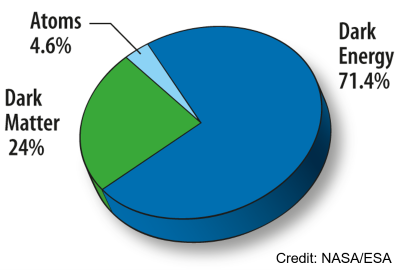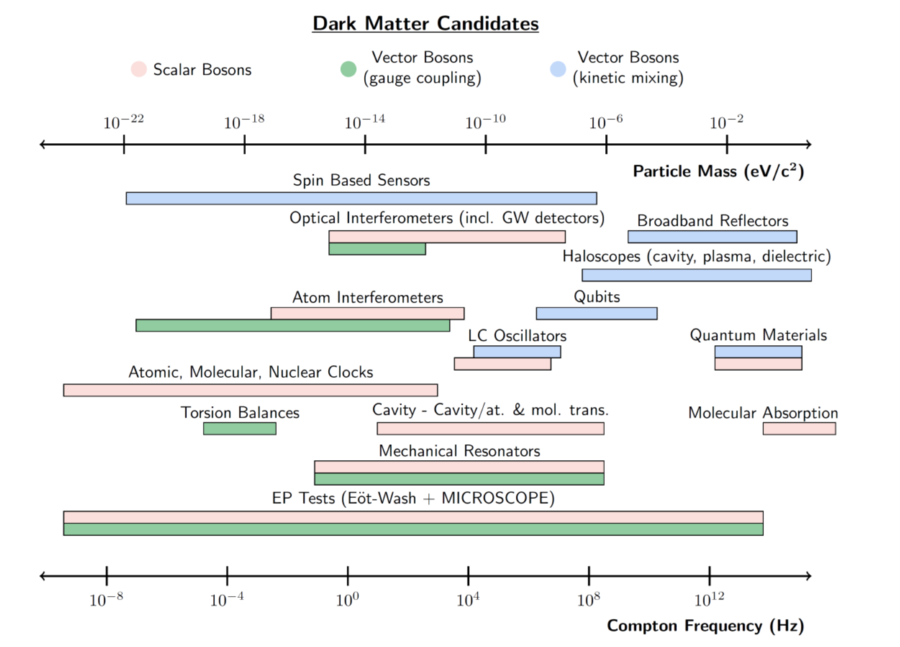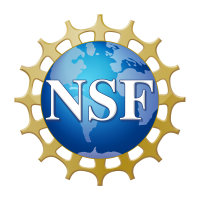Dark matter searches
We do not know what Universe is made of!
A large number of astrophysical and cosmological measurements at many different scales suggest that more than 80% of all matter in the Universe is invisible, nonluminous dark matter (DM) which is not explained by the standard model (SM). Understanding the nature of dark matter is one of the biggest fundamental problems in modern science. Solving this problem will not only reveal the composition of the Universe, but can also offer insights into the cosmology of the early Universe, uncover new physical laws, and potentially lead to the discovery of other fundamental forces.

The past decade has seen unprecedented effort in dark matter model building at all mass scales coupled with the design of numerous new detector types. In particular, transformative advances in quantum technologies have led to a plethora of new high-precision quantum devices joining the search for ultralight dark matter (UDM) with mass less than 10 eV.
Such UDM candidates act as coherent entities on the scale of individual detectors or networks of detectors, leading to a new detection paradigm. UDM fields may cause precession of nuclear or electron spins, drive currents in electromagnetic systems, produce photons, or induce equivalence-principle-violating accelerations of matter. They may also modulate the values of the fundamental “constants” of nature, which would in turn induce changes in atomic transition frequencies and local gravitational field and affect the length of macroscopic bodies.

Summary of current and future laboratory direct-detection experiments to set constraints on scalar and vector dark matter. Source: arXiv:2203.14915.
The unprecedented progress in controllable quantum systems and other precision measurement technologies has profound implications on our ability to detect such ultralight (wavelike) dark matter. In the past ten years, precision searches for UDM with quantum technologies have emerged as a vibrant research area, with many promising new proposals joining several ongoing experiments. In fact, a key impact of the emergent second quantum revolution should be on fundamental physics, i.e., using quantum entanglement to discover new phenomena.
Recent research highlights
Detection of Bosenovae with Quantum Sensors on Earth and in Space

In a broad class of theories, the accumulation of ultralight dark matter (ULDM) with particles of mass 10-22 eV < m < 1 eV leads to the formation of long-lived bound states known as boson stars. When the ULDM exhibits self-interactions, prodigious bursts of energy carried by relativistic bosons are released from collapsing boson stars in bosenova explosions. We extensively explore the potential reach of terrestrial and space-based experiments for detecting transient signatures of emitted relativistic bursts of scalar particles, including ULDM coupled to photons, electrons, and gluons, capturing a wide range of motivated theories.
Detection of Bosenovae with Quantum Sensors on Earth and in Space, Jason Arakawa, Joshua Eby, Marianna S. Safronova, Volodymyr Takhistov, Muhammad H. Zaheer, submitted to Phys. Rev. D, arXiv:2306.16468 (2024).
New Constraints on Dark Matter and
Cosmic Neutrino Profiles through Gravity

Schematic visualization of the perihelion precession of Bennu that would be caused by dark matter. Local gravitating matter, including dark matter or cosmic neutrinos, could cause presessions of asteroid orbits.
We derive purely gravitational constraints on dark matter and cosmic neutrino profiles in the solar system using asteroid (101955) Bennu. We focus on Bennu because of its extensive tracking data and high-fidelity trajectory modeling resulting from the OSIRIS-REx mission. We constrain the local density of dark matter and show that high-precision tracking data of solar system objects can constrain cosmic neutrino overdensities relative to the Standard Model prediction comparable to the existing bounds from KATRIN and other previous laboratory experiments (with mν the neutrino mass). These local bounds have interesting implications for existing and future direct-detection experiments.
Our constraints apply to all dark matter candidates but are particularly meaningful for scenarios including solar halos, stellar basins, and axion miniclusters, which predict or allow overdensities in the solar system. These constraints can be improved in the future as the accuracy of tracking data improves, observational arcs increase, and more missions visit asteroids.
New Constraints on Dark Matter and Cosmic Neutrino Profiles through Gravity, Yu-Dai Tsai, Joshua Eby, Jason Arakawa, Davide Farnocchia, Marianna S. Safronova, JCAP 02, 029 (2024).
Oscillating nuclear charge radii as sensors for ultralight dark matter
It was previously assumed that ratios of optical clock frequencies are only sensitive to the variation of the fine-structure constant, enabling searches for ultralight dark matter (UDM) that couples to the electromagnetic sector of the standard model. In this work, we show that there are additional observable effects due to coupling of UDM to quarks and gluons would lead to an oscillation of the nuclear charge radius detectible with optical clocks.

Exclusion plot for the linear scalar dark matter (DM) coupling to the gluons dg as a function of DM mass.
We show that coupling of ultralight dark matter (UDM) to quarks and gluons would lead to an oscillation of the nuclear charge radius for both the quantum chromodynamics (QCD) axion and scalar dark matter. Consequently, the resulting oscillation of electronic energy levels could be resolved with optical atomic clocks, and their comparisons can be used to investigate UDM-nuclear couplings, which were previously only accessible with other platforms.
Oscillating nuclear charge radii as sensors for ultralight dark matter, Abhishek Banerjee, Dmitry Budker, Melina Filzinger, Nils Huntemann, Gil Paz, Gilad Perez, Sergey Porsev, Marianna Safronova, arXiv:2301.10784 (2023)
Other relevant recent publications (2020-2024)
- Quantum metrology algorithms for dark matter searches with clocks, M. H. Zaheer, N. J. Matjelo, D. B. Hume, M. S. Safronova, D. R. Leibrandt, arXiv:2302.12956 (2024).
- Bosenovae with Quadratically-Coupled Scalars in Quantum Sensing Experiments, Jason Arakawa, Muhammad H. Zaheer, Joshua Eby, Volodymyr Takhistov, Marianna S. Safronova, submitted to JHEP, arXiv:2402.06736 (2024).
- Terrestrial Very-Long-Baseline Atom Interferometry: Workshop Summary, Sven Abend at al., AVS Quantum Sci. 6, 024701 (2024).
- Direct detection of ultralight dark matter bound to the Sun with space quantum sensors, Yu-Dai Tsai, Joshua Eby and Marianna S. Safronova, Nature Astronomy 7, 113 (2023).
- Quantum Sensors for High Energy Physics, Aaron Chou et al., arXiv:2311.01930 (2024).
- The Phenomenology of Quadratically Coupled Ultra Light Dark Matter, Abhishek Banerjee, Gilad Perez, Marianna Safronova, Inbar Savoray, Aviv Shalit, J. High Energ. Phys. 2023, 42 (2023).
- New Horizons: Scalar and Vector Ultralight Dark Matter, D. Antypas et al., arXiv:2203.14915 (2022).
- Measuring the stability of fundamental constants with a network of clocks, G. Barontini at al., EPJ Quantum Technology 9, 12 (2022).
- Snowmass 2021: Quantum Sensors for HEP Science – Interferometers, Mechanics, Traps, and Clocks, Oliver Buchmueller, Daniel Carney, Thomas Cecil, John Ellis, R. F. Garcia Ruiz, Andrew A. Geraci, David Hanneke, Jason Hogan, Nicholas R. Hutzler, Andrew Jayich, Shimon Kolkowitz, Gavin W. Morley, Holger Muller, Zachary Pagel, Christian Panda, Marianna S. Safronova, arXiv:2203.07250 (2022).
- Cold Atoms in Space: Community Workshop Summary and Proposed Road-Map, Ivan Alonso et al., EPJ Quantum Technol. 9, 30 (2022).
- Fundamental Physics with a State-of-the-Art Optical Clock in Space, Andrei Derevianko, Kurt Gibble, Leo Hollberg, Nathan R. Newbury, Chris Oates, Marianna S. Safronova, Laura C. Sinclair, Nan Yu, Quantum Sci. Technol. 7, 044002 (2022).
- Quantum technologies and the elephants, M. S Safronova and Dmitry Budker, Quantum Sci. Technol. 6, 040401 (2021).
- Nuclear clocks for testing fundamental physics, E. Peik, T. Schumm, M. S. Safronova, A. Pálffy, J. Weitenberg, and P. G. Thirolf, Quantum Sci. Technol. 6, 034002 (2021).
- Probing the Relaxed Relaxion at the Luminosity and Precision Frontiers, Abhishek Banerjee, Hyungjin Kim, Oleksii Matsedonskyi, Gilad Perez, Marianna S. Safronova, J. High Energ. Phys. 2020, 153 (2020).
- Optical clocks based on the Cf 15+ and Cf 17+ ions, S. G. Porsev, U. I. Safronova, M. S. Safronova, P. O. Schmidt, A. I. Bondarev, M. G. Kozlov, I. I. Tupitsyn, Phys. Rev. A 102, 012802 (2020).

Supported by the National Science Foundation
NSF-BSF: Development of High-Precision Atomic Methods and Dark Matter Searches, NSF Division of Physics, Award Number # 2309254.
NSF-BSF: High-Precision Atomic Methodologies and New Physics Searches, NSF Division of Physics, Award Number # 2012068.
QLCI-CI: NSF Quantum Leap Challenge Institute for Enhanced Sensing and Distribution Using Correlated Quantum States, NSF organizations: OMA and MPS Multidisciplinary Activities, Award Number # 2016244.
